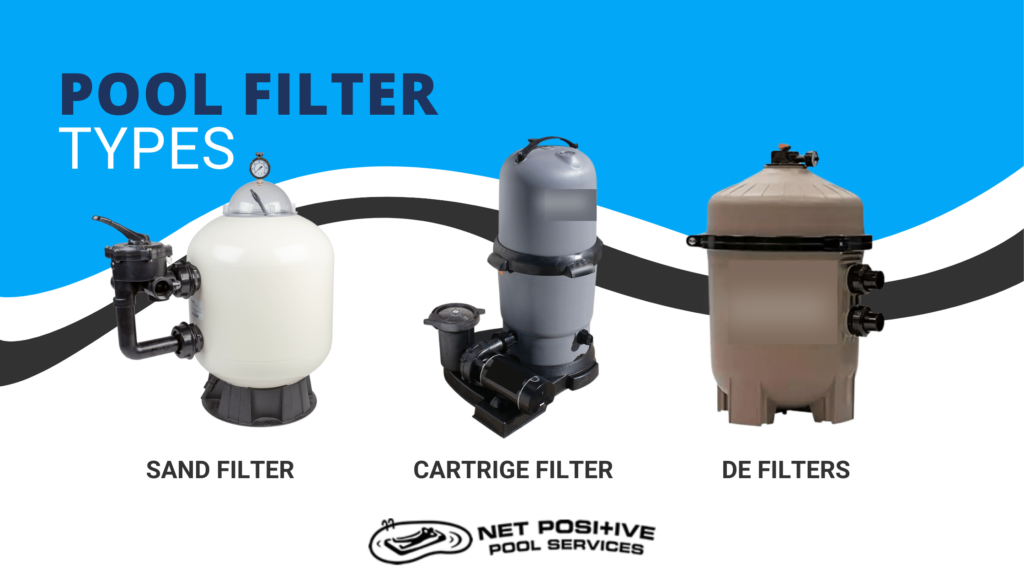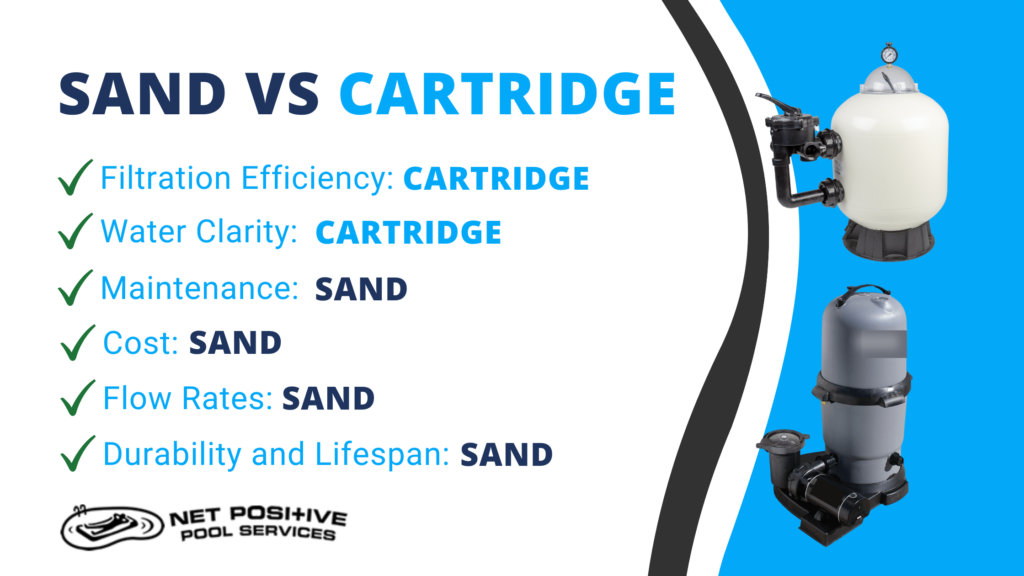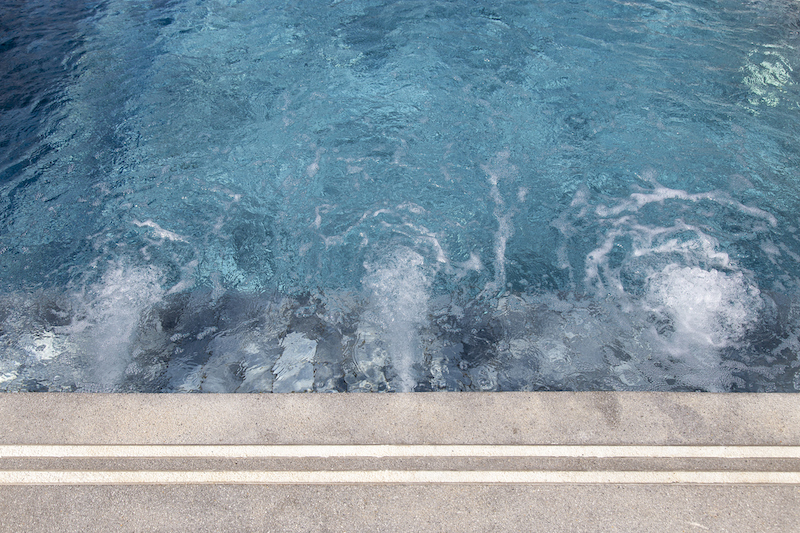Every pool owner wants crystal-clear water, but building and maintaining a perfect pool system is easier said than done. Proper filtration is one of the most important aspects, and the filter you choose can make all the difference in clean water and upkeep. So, in the interest of keeping your swimming pool’s water sparkling clean and your filter expectations met, here’s the low-down on pool filters.
All pools have filters, but not all filters are created equally. The three primary types you’ll find are sand, cartridge, and DE (Diatomaceous Earth) filters. Let’s look at the pros and cons of each and figure out which is right for your backyard oasis.
Understanding Microns
First, let’s start with some basics, microns. A micron is a unit of measurement used to describe the size of particles. In the context of pool filters, the micron measurement refers to the size of particles that the filter can effectively capture and remove from the water. A smaller micron rating indicates that the filter can capture smaller particles, while a larger micron rating means it can only capture larger particles.
When selecting a pool filter, understanding the micron rating is important because it determines the filter’s ability to remove different types of debris and impurities from the water.
It’s important to note that the micron rating alone doesn’t guarantee optimal filtration. Other factors such as filter media type, filter design, flow rate, and overall system maintenance also play significant roles in filtration efficiency. With these considerations in mind, let’s dive into the world of pool filters.

Sand Filters
Sand pool filters are one of the oldest methods for keeping pool water clear. It’s a simple concept. The filter tank is large and spherical, and it is filled with silica or filter sand. The pump moves the pool water through the sand. Since the sand granules have rough edges, they capture particulates and contaminants as the water moves through. Clean water is then returned to the pool.
There are some great advantages to sand filters. To start, they are really simple and relatively inexpensive. And you only have to replace the sand every five years or so.
But that doesn’t mean they are maintenance-free. Sand filters must be backwashed, a process where the flow of water is reversed to clean the sand of any debris and grime. The dirty water is drained, and the filter flow returns to normal. You’ll lose some water doing a backwash, which means your water chemistry will likely be thrown off a little. None of this is a deal-breaker, but it does add to the overall cost and chore list.
Overall, sand is a good filter but not a great filter. Most people estimate that sand will catch tiny particles between 40 and 20 microns. This is much smaller than the width of a single human hair but still big enough to allow some contaminants to remain in the pool. So, keeping your chemicals in check to kill any dangerous bacteria is all the more important with a sand filter.
Cartridge Filters
A cartridge pool filter uses pleated cartridges to filter the water. In terms of micron ratings, they’re more effective than sand, and most filter down to about 10 microns or so. That means that smaller particles are captured, leaving you with cleaner water.
There are a few different styles of cartridge filters on the market. Most small backyard pools will use a simple single-filter model. These are smaller than a sand filter and better where space in the equipment area is limited. Hot tubs often use a smaller version with a smaller filter to trap particles. For larger pools, you can get quad-filter models that use four filter elements to increase the filtering surface area.
The cartridges themselves are more expensive than sand and must be replaced more often. The good news, however, is that they are easily cleaned with pressure spraying from a garden hose. This will remove most of the gunk off the outside of the filter, allowing it to keep working. For deeper cleans, you can soak filters overnight in a filter-cleaning solution. Some folks like to have a few filters on hand, so they can simply swap in a good one and clean the dirty one at their leisure.
Most pool owners find they need a few deep filter cleanings over the course of a season and a new cartridge every few years. So, all in all, the cost of keeping an appropriately-sized cartridge filter is very reasonable.
As you may have already figured out, one downside to the cartridge filters is that there’s a little more hands-on maintenance required on your part. With a sand filter, you simply switch the multiport valve and let it backwash. But when a cartridge gets dirty, you’ll have to remove it and clean it with a hose.

Breaking Down Sand Filters vs Cartridge Filters
So, here’s a look at how these two types of pool filters compare by the numbers.
Filtration Efficiency—Cartridge filters have the best efficiency, with filter ratings of around 10 microns.
Water Clarity—Cartridge-style filters produce the clearest water simply due to their increased filtration efficiency. They filter out all but the smallest particles.
Maintenance—Sand filters have lower maintenance requirements. They simply require backflushing when the pressure gauge indicates the filter is getting dirty. Cartridges, on the other hand, must be removed from their housings and hosed off. Additionally, they’ll need a deep clean with filter cleaning solution about twice a year. Just remember, regardless of which type of filter you choose, cleaning the system and ensuring adequate water flow on a regular basis is the key to trouble-free ownership.
Cost—Sand filters are the cheapest option, and the silica filter media is relatively inexpensive. You’ll often see them with above-ground pool installations. Cartridge filter housings and the filter cartridge itself are more expensive, and the filters need to be replaced more often.
Flow Rates—The best flow will come from a sand filter. Sand filters are usually the preferred option if you have a very large pool with a large, high-flow pump.
Durability and Lifespan—Sand filters last a long time; most owners go five years or more between changing the filter medium. Cartridges need to be replaced every year or two.
DE Filters
Another pool filter that isn’t discussed as often is the D.E. filter or the “diatomaceous earth filter.” These work like sand filters; only the filter media is diatomaceous earth instead of silica sand. This is a very fine powder, so these filters get much more gunk out of your water. The best thing about D.E. filters, however, is that they filter very small particles, down to 2 microns or so, meaning super clear water is the result.
The downside and the reason they aren’t as common? They’re expensive, as is the DE media to fill it. But if you want the absolute best in water clarity, these are the Cadillacs of pool filters.

Other Factors to Consider When Choosing Your Pool Filter
Of course, picking the right filter for your situation is a little more complex than just picking the one you like. The filter is part of the pool system, and you want to ensure your filter and pump are sized correctly.
The first thing to consider is the size of your pool. A filter’s flow rate is the maximum amount of water it can clean in gallons per hour. This must be at least or more than the GPH rating of your pump. The turnover is how many hours it takes to clean the entire pool, so the turnover of the filter must be at least the size of your pool.
A filter is only effective if the correct pump size is installed in the system. The pool pump needs to move the water as indicated above, and the filter should be able to handle cleaning that much water.
It’s always advisable to oversize your filter for your pump’s flow and turnover rates. This will ensure that the pool gets cleaned with every turnover, even if the filter isn’t working at 100 percent. It also means you’ll reduce the pump’s load, ensuring it will last as long as possible. Multi-speed pumps can run at lower speeds, saving energy. And, even better, you’ll have to clean your filter or backflush less often.
Your Go-To Pool Service Company in the South
If you’re looking for answers to your pool and filtration-related problems, look no further than Net Positive Pools. Whether you’re looking to install a new system, upgrade your current filtration, or simply maintain your pool, it’s always helpful to have experienced experts to turn to. With locations in South Carolina, North Carolina, and Georgia, Net Positive Pools offers a range of pool cleaning, maintenance, and equipment services so owners can stop stressing about their filtration systems and start enjoying their swimming pools.
Ready for clean, clear, and safe water this summer? Contact your closest Net Positive Pools, we’re here to help.


